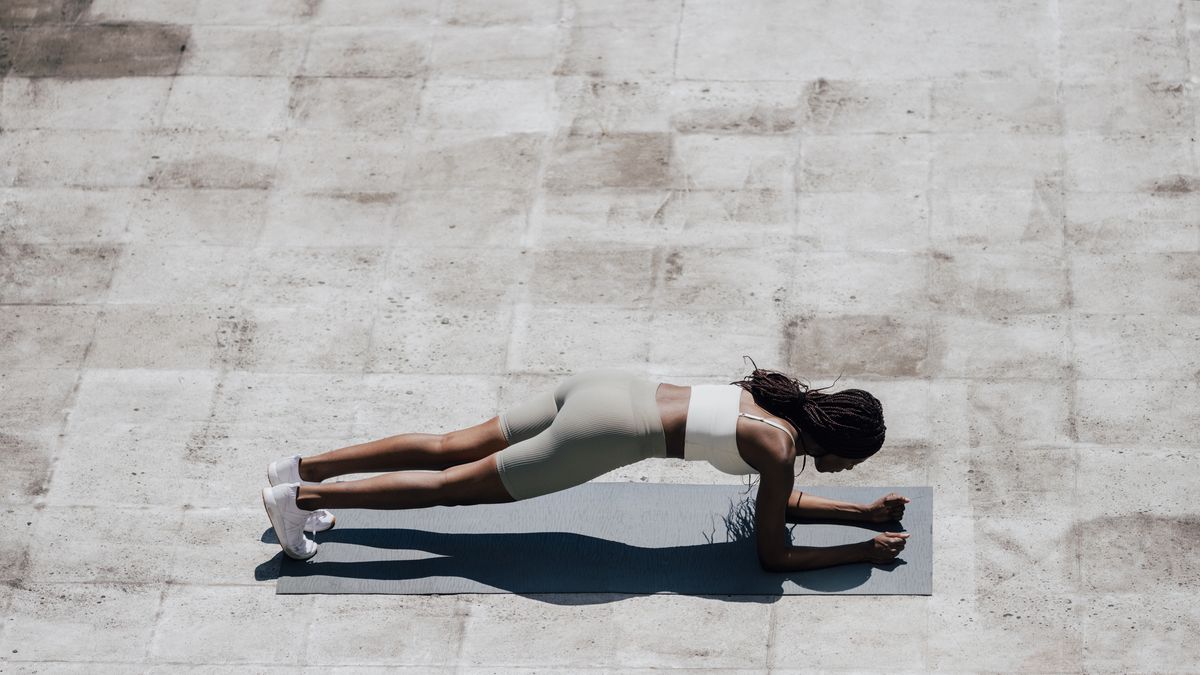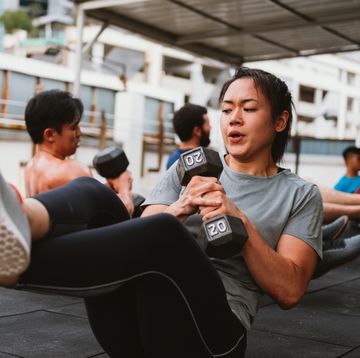By the time I’m halfway through a cycling class, my leg muscles feel like they’re ablaze. When I’m doing my final few bridge pulses in a reformer Pilates session, my glute muscles will begin to burn and quiver. When the workout burn is real, it's a sign your muscular endurance is being put to the test.
I know I’m not the only one feeling the sizzle either: A quick look around these rooms proves nearly all of my grimacing classmates are experiencing the same hurts-so-good side effects.
Meet the experts: Kristie Larson, CPT, is a NASM-certified personal trainer and body-neutral strength coach in New York.
Regularly training and improving muscular endurance can level up your workout performance, lifting technique, and daily functioning. Here's everything to know about muscular endurance, how it differs from muscular strength, and the best ways to train it, straight from a trainer.
What is muscular endurance?
Muscular endurance is the ability of a muscle to continue working for a prolonged period of time, says Kristie Larson, CPT, body-neutral strength coach based in New York. To be more specific, it’s your muscle’s ability to produce and maintain a particular level of force for a long duration, according to the National Academy of Sports Medicine (NASM).
Imagine yourself doing a round of biceps curls. To challenge your muscular endurance, you’ll perform a high number of reps of the arm exercise while using a relatively light weight, says Larson. Muscular endurance also comes into play with isometric exercises, which means your muscles are contracting but your body isn’t actively moving, according to NASM. A plank is a good example. Your core muscles will need to contract—and maintain that contraction—for as long as possible, she notes.
To put it simply, “the longer you can go, the more endurance you've built,” she says. If you notice your max rep count for biceps curls jumped from, say, 12 to 15 and your plank PR increased from 45 to 60 seconds after a month of training, that’s a sign your muscular endurance has improved.
On the flip side, muscular strength refers to the greatest amount of force a muscle can generate, according to the National Strength and Conditioning Association (NSCA). Exercises that test and build your muscular strength will generally use heavier weights and lower rep ranges, says Larson. If your one-rep max (the heaviest weight you can safely lift for a single repetition) for biceps curls increased from 15 pounds to 22 pounds after a few months of training, that indicates your muscular strength has built up.
Muscular endurance vs. strength: Muscular strength is the greatest amount of load that you can safely move, says Larson. With muscular endurance, on the other hand, "you're working on being able to fire that muscle for longer, get more repetitions out of that muscle or prolong the amount of time that the muscle can work."
Benefits Of Muscular Endurance
- Instill proper form. Training for muscular endurance is particularly beneficial for lifting newbies, as the lighter (read: less taxing) loads allow you to focus more heavily on your technique, says Larson. In turn, “it lays the groundwork before progressing to heavier loads,” she notes. Once you’ve nailed down your form via muscular endurance training, you know to use just your biceps to bring your heavy dumbbells up to your shoulders during strength-building hammer curls, for instance. That knowledge is a surefire way to make your workout more effective and reduce your risk of injury.
- Promote healthy posture. In order to sit and stand slouch-free, your core muscles (which consist of your rectus abdominis, erector spinae, obliques, transverse abdominis, and other muscles) need to be engaged. And that means you need sufficient muscular endurance in the muscle group to constantly maintain that upright positioning, says Larson. “Even if it's as simple as you want to be able to stand comfortably for a few hours at a time, you need muscular endurance,” she adds. Core endurance has also been found to be an important factor in core stability, according to research published in Sports Health, which plays a role in maintaining a neutral spine and optimal trunk positioning.
- Support daily activities. Everyday activities such as walking around the neighborhood, climbing up your apartment building’s staircase, and mowing the lawn all rely on muscular endurance. Improving your levels can help keep fatigue at bay. And that’s exactly why Larson recommends everyone practice some muscular endurance training. “A lot of the stuff that we do in daily life, we're doing for a prolonged period of time,” she adds. “If you want to go for a hike, for example, that might last hours, and you want to make sure that you're feeling good throughout the whole thing.”
- Improve cardio performance. Pretty much any activity that involves aerobic endurance (read: exercise that challenges your cardiovascular and respiratory systems and is performed below your max for prolonged periods of time) also involves muscular endurance, says Larson. Just think of cycling: Although it’s primarily considered a cardio activity, stressing your heart and lungs, your leg muscles are powering the movement for the entire workout, she explains. So if you build up endurance in your quads, hamstrings, and calves, you’ll feel less fatigued toward the end of your workout—and you may even see a performance boost as a result.
- Move safely through injuries. Folks recovering from injuries will often have muscular endurance training incorporated into their wellness program, says Larson. “When tissue is remodeling, you always run the risk of disturbing those fibers that are regenerating [during exercise],” she explains. “You have to be very careful to manage the load you're using so that you’re continuing to stress the new tissues appropriately without actually disturbing the healing process. Usually, the way that happens is through gradually increasing endurance, gradually increasing load, and then past a certain point, you can start to pursue actual strength gains.”
How To Improve Muscular Endurance
Those perks are pretty enticing if you ask me, and it's not hard to work on your muscular endurance. To start enhancing it, you’ll want to incorporate a mix of isometric bodyweight exercises and low-load, high-rep resistance moves into your routine, says Larson.
Isometric movements, such as planks, wall sits, and sumo squat holds, can easily be performed for time and don’t require additional load, so you won’t need to count your reps or calculate the exact weight you need for each move. Though you won’t do many isometric movements IRL, they help build and maintain postural control so you can better resist external forces, such as the pull of a heavy grocery bag or the lurch of a subway car. (Cool, right?)
Staying still your whole workout can feel a bit stale. That’s why loaded resistance moves, which come with set rep ranges and the option of progressing with heavier weights as you build up strength elsewhere in your routine, can also be useful for muscular endurance. Single-joint exercises in particular, such as lateral raises, biceps curls, and glute bridges, can be particularly beneficial for improving muscular endurance for fitness newbies, says Larson.
“Single-joint moves give you that feeling of the muscle working, so they can help with [establishing] mind-muscle connection,” Larson explains. “For example, when you get up to 12 reps of lateral raises, you're going to really feel your delts working and you're going to have awareness of how to execute the movement, which can lay a really good foundation for beginners to build on.”
Ideally, you want muscular endurance exercises to make up about 25 percent of your training, regardless of your fitness level, to score their benefits, says Larson.
For the bodyweight isometric exercises, do one to three sets, holding the contraction for as long as possible while maintaining proper form, says Larson. With resistance-based moves, aim to do one to three sets of 10 to 15 reps using a medium to heavy weight (about 65 percent of your one-rep max if you know it). Minimize your rest breaks (less than 30 seconds) in between sets, which will bring about high levels of metabolic stress, according to the NSCA.
Best Muscular Endurance Exercises
1. Lateral Raise
Why it rocks: This endurance-building exercise targets your deltoids, which come into play during many upper-body movements (think: the shoulder press, pushup, and front raise) and your daily life, such as when you’re grabbing a box of cereal off the top of the fridge, says Larson.
How to:
- Stand with feet hip-width apart, toes pointed forward, knees slightly bent, and arms at sides, holding a light dumbbell in each hand with palms facing each other.
- Draw shoulders down and back and engage core to protect spine. (Imagine bracing stomach as if someone is about to punch you in the gut.)
- On an exhale, raise both arms up to shoulder height at sides of body, slightly in front of chest. Palms should be facing the floor at the top of the raise. Allow elbows to keep a slight bend throughout the movement.
- Pause, then on an inhale, lower both arms back to sides of body. That’s 1 rep. Complete 10 to 15 reps, then repeat for up to three rounds.
2. Calf Raise
Why it rocks: Improving endurance in your calf muscles can have significant performance benefits, says Larson. “Things like walking and running are really reliant on the calves, so building calf strength [and endurance] can help with in any sports that involve running, cutting, and jumping,” she says.
How to:
- Stand with feet hip-width apart, toes pointed forward, and hands resting on hips or fingertips gently touching a wall in front of body for added stability. (Optional: Hang arms at sides and hold a light dumbbell in each hand with palms facing each other.)
- Draw shoulders down and back and engage core to protect spine. (Imagine bracing stomach as if someone is about to punch you in the gut.)
- On an exhale, press into balls of feet and toes and lift both heels off the floor as high as possible.
- Pause, then on an inhale, lower both heels back to the floor. That’s 1 rep. Complete 10 to 15 reps, then repeat for up to three rounds.
3. Isometric Lunge (Split Squat Hold)
Why it rocks: “For most people, the weakest position of a lunge is that bottom position,” says Larson. “So finding a bottom position that has really solid form and building endurance in that end-range position can help you move into that position when you're doing constant reps.”
How to:
- Stand with feet slightly wider than hip-width apart, toes pointed forward, and hands resting on hips.
- Draw shoulders down and back and engage core to protect spine. (Imagine bracing stomach as if someone is about to punch you in the gut.)
- Keeping left toes grounded on the floor, step right foot forward two to three feet, right foot planted flat.
- Bend right knee to a 90-degree angle, allowing left knee to bend to a 90-degree angle and hover a few inches off the floor.
- Hold this position, keeping breath steady and left knee hovering a few inches off the floor.
- Rest, then switch sides.
- Repeat up to three times.
4. Underhand Row
Why it rocks: Targeting the back and biceps, the underhand row uses a pulling motion and an underhand grip, which you call on in your everyday life (opening a heavy door, lifting a heavy box off the ground), says Larson. “I also like the hinge positioning of an underhand row, and building endurance by holding that position strongly can translate over to a lot of other exercises,” says Larson. Working this move can help with your good morning and deadlift form.
How to:
- Stand with feet hip-width apart, toes pointed forward, and arms at sides, holding a light dumbbell in each hand with palms facing forward.
- Draw shoulders down and back and engage core to protect spine. (Imagine bracing stomach as if someone is about to punch you in the gut.) Bend knees slightly and hinge forward at hips to roughly a 45-degree angle.
- On an exhale, drive elbows up toward hips until upper arms aligned with body. Keep arms tucked close to sides, imagining you’re squeezing a lemon between armpits.
- Pause, then on an inhale, lower dumbbells back to the floor until arms are fully extended. That’s 1 rep. Complete 10 to 15 reps, then repeat for up to three rounds.
5. Good Morning
Why it rocks: Practicing the good morning exercise and building muscular endurance in the posterior chain helps you become so familiar with the hinge position, it feels automatic when you perform challenging strength and power moves such as deadlifts and kettlebell swings, says Larson.
- Stand with feet hip-width apart, toes pointed forward, knees slightly bent, and fingertips resting gently behind ears. (Option to hold a dumbbell behind back as shown.)
- Draw shoulders down and back and engage core to protect spine. (Imagine bracing stomach as if someone is about to punch you in the gut.)
- On an inhale, hinge forward at hips to lower torso toward the floor, allowing butt to push back slightly. Continue hinging until torso is parallel with floor or hamstrings feel a stretch.
- On an exhale, press through feet and drive hips forward to lift torso back up to standing. That’s 1 rep. Complete 10 to 15 reps, then repeat for up to three rounds.
How To Measure Muscular Endurance
Although trackers are useful for many markers of fitness, they can’t measure muscular endurance, says Larson. Instead, you can test your muscular endurance by performing an isometric exercise and timing how long you can hold the contraction, she suggests. Or, you can choose a resistance-focused exercise, select a lighter weight (one that syncs with a RPE of 6 or 7), and perform as many reps as possible until your form fails or you reach failure (your muscle simply can’t perform another contraction), she adds.
Take note of the amount of time or number of reps you performed and repeat a few weeks later to see how your muscular endurance is improving. Once you’re able to easily bang out 20 or more reps of the loaded resistance exercises, that’s your cue to amp up the weight you're using, says Larson.
How long does it take to improve muscular endurance?
Beginners can generally expect to see improvements after about two weeks of training, says Larson. “In general, people who are more experienced see much more subtle, gradual changes than people who are beginners,” she adds.
It can take a bit longer to register an increase, too. Both traditional weight training and CrossFit improved muscular endurance (as measured by squat and push-up reps) after eight weeks of twice-weekly workouts, one study on 85 college students found.
Still, there’s no set amount of time it takes to build up muscular endurance. If you’re feeling frustrated with your progress (or lack thereof), don’t be afraid to reach out to a pro who can help you reach your goals and push through that plateau.

















